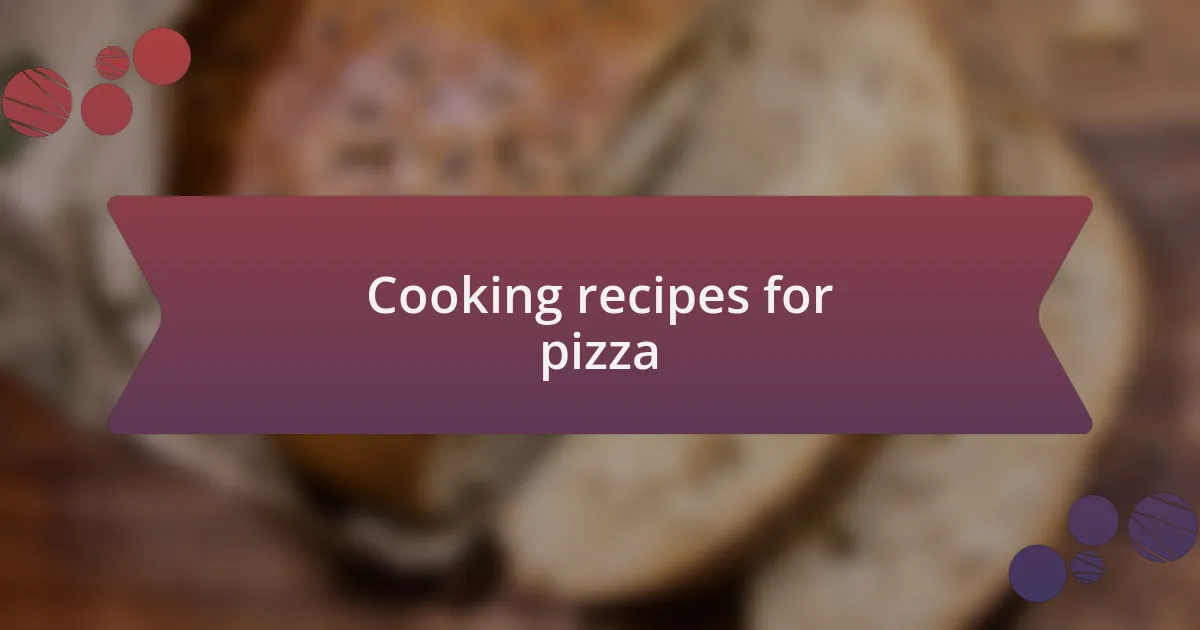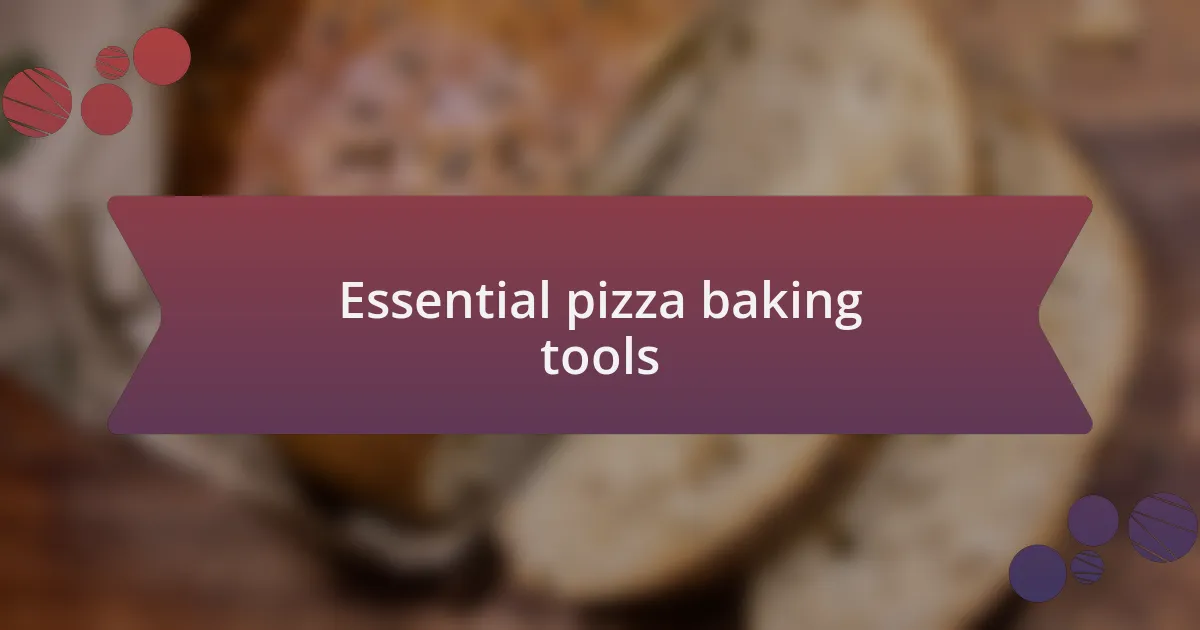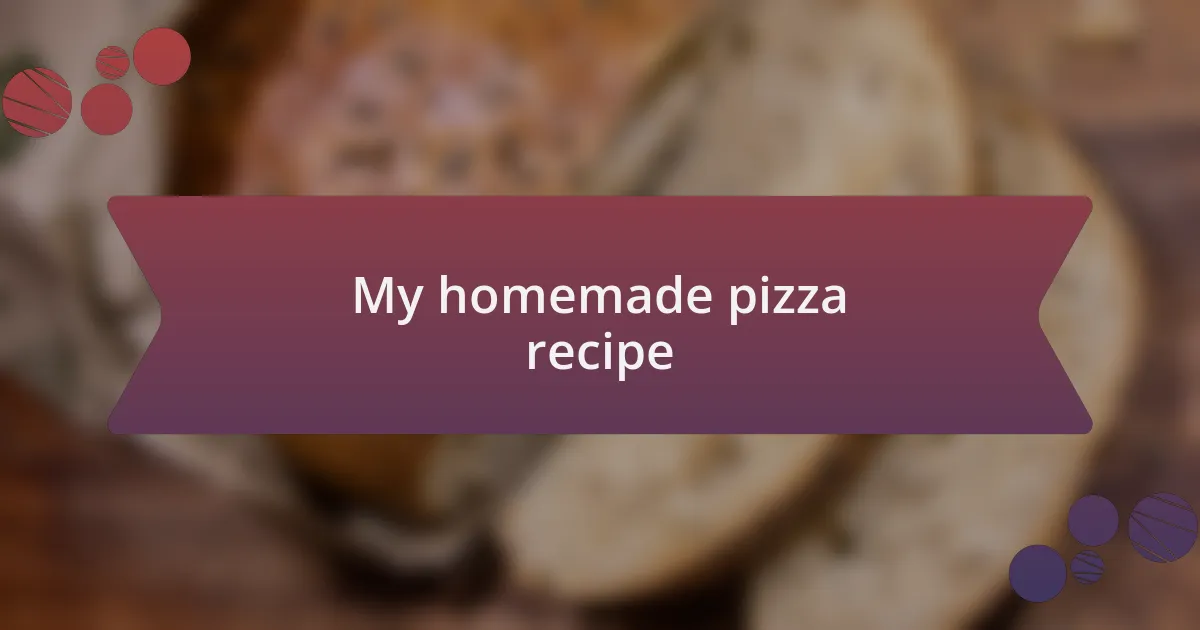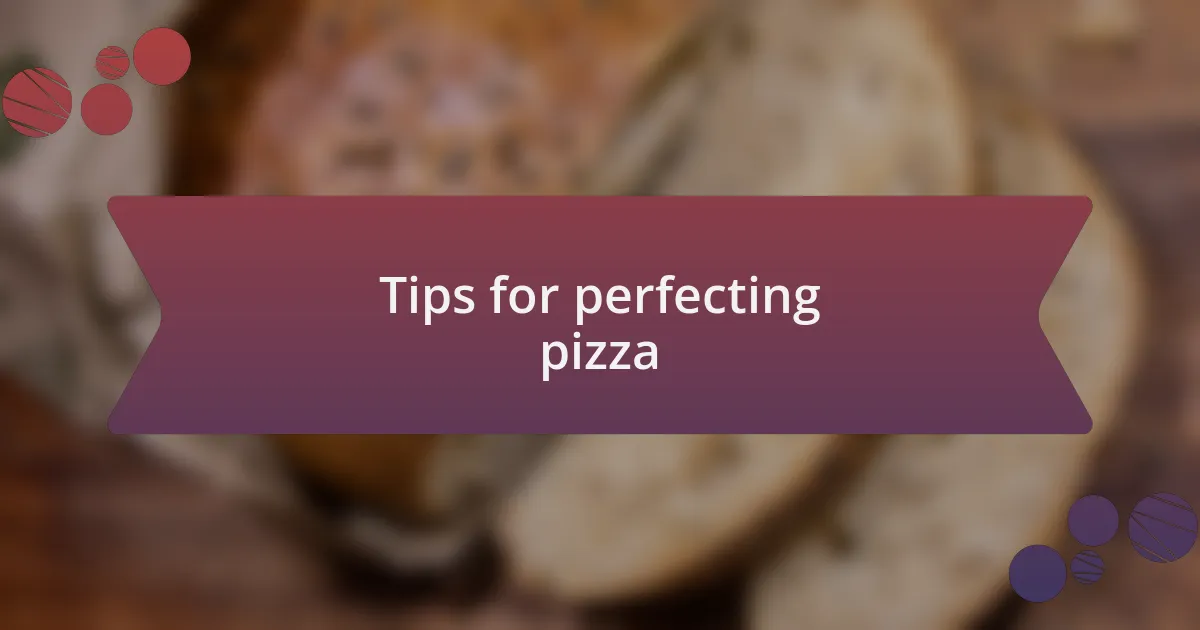Key takeaways:
- The dough is crucial for pizza; using the right flour and hydration level can significantly enhance the crust’s texture and flavor.
- Experimenting with toppings can lead to unique flavor combinations, while balance is key in choosing meats to avoid overwhelming flavors.
- Essential tools like a pizza stone, peel, and cutter improve the baking experience and final pizza quality.
- Baking at a high temperature and allowing dough to rest after kneading are vital practices for achieving the best results.

Cooking recipes for pizza
When it comes to cooking recipes for pizza, I can’t stress enough how the dough is the foundation of your pie. The first time I made pizza from scratch, I was astounded by how much a simple yeast, flour, and water mixture could transform into something magical. Have you ever felt that thrill when the dough rises just perfectly? It’s a moment I cherish every time.
As for the sauces, don’t underestimate the power of a homemade tomato sauce. I remember experimenting with fresh basil and garlic, and oh, the aroma filled my kitchen! It’s these small choices that can elevate your pizza to restaurant-level quality. Have you tried adding a hint of red pepper flakes for a little kick?
Toppings are where your creativity can really shine. I’ve had my share of unconventional toppings, like figs and goat cheese, which might sound odd but have brought incredible flavor combinations to my pizza nights. What are your go-to toppings? Each ingredient not only adds tastes but also tells a story, making every homemade pizza a reflection of your palate and mood.

Understanding pizza dough
Understanding the ideal pizza dough is crucial for crafting the perfect crust. The texture and flavor depend on the type of flour you use; I discovered this firsthand when I switched from all-purpose to bread flour. Suddenly, my dough had that delightful chewiness, transforming my pizzas from good to unforgettable.
When I first experimented with the hydration level—essentially the amount of water in the dough—I was nervous about getting it right. It’s fascinating how a slight adjustment can yield a soft, airy crust versus a denser, bread-like texture. Have you ever noticed how your dough seems to take on a life of its own in response to these small changes?
The fermentation process is another critical factor. Allowing the dough to rest and rise slowly made my crust develop an incredible depth of flavor. I still remember the anticipation as I waited for the dough to double in size; that moment felt like magic. Isn’t it incredible how patience in the kitchen can lead to such delicious outcomes?

Selecting pizza toppings
Selecting toppings for your pizza is like painting on a canvas—it can truly make or break the final dish. Personally, I love starting with a classic base of tomato sauce and mozzarella, but then the fun begins. I often think about how each topping has its own unique personality; for instance, fresh basil adds a vibrant aroma that makes the pizza feel fresh and alive. Isn’t it amazing how a sprinkle of herbs can elevate the entire experience?
When it comes to meats, I found that balance is key. I once overloaded a pizza with pepperoni and sausage, thinking more is better, but the flavors became overwhelming. Now, I focus on contrasting tastes. For instance, a mild chicken paired with spicy jalapeños creates a delightful interplay that keeps each bite exciting. Have you ever tried a combo that took you by surprise in a good way?
Experimenting with unconventional toppings can also yield delightful surprises. I remember the first time I topped a pizza with figs and gorgonzola—it felt daring, yet I was thrilled with the result. The sweetness of the figs balanced the salty creaminess of the cheese beautifully. Why not try mixing tropical elements, like pineapple or mango, with savory components? It’s these little experiments that can turn your pizza nights into a culinary adventure.

Essential pizza baking tools
When it comes to baking the perfect pizza, having the right tools is essential. A quality pizza stone truly transformed my baking experience. I still remember the first time I slid a pizza onto it—the crust emerged with a delightful crisp that I had been chasing for ages. This stone retains heat beautifully, creating that coveted restaurant-quality texture, and it’s a game-changer in my kitchen.
Another tool I cannot live without is a pizza peel. The first time I used one, I felt like a professional chef. It allows for easy transferring of the pizza in and out of the oven, which, trust me, makes a world of difference. I vividly recall my failed attempt to use a baking sheet instead; let’s just say, it didn’t end well! The peel not only prevents mess but also gives a satisfying “whoosh” as it glides under the pizza.
Lastly, I highly recommend investing in a pizza cutter. Initially, I thought a regular kitchen knife would suffice, but oh boy, was I wrong! The joy of slicing through a perfectly baked pizza with ease is unmatched. I remember the first time I tried to cut a pizza with a dull knife—it was a disaster! A good cutter means less mess and more time enjoying that cheesy goodness. Have you ever found yourself struggling with a knife when all you wanted was a delicious slice?

My homemade pizza recipe
My homemade pizza recipe revolves around a simple yet effective dough that I’ve honed over the years. The key for me was discovering the right balance of ingredients—just the right amount of flour, water, yeast, and a pinch of salt. I remember the excitement of kneading that dough for the first time; it was like shaping my culinary destiny. With practice, I learned to let the dough rise properly, and the smell that fills the kitchen while it’s proving is nothing short of heavenly.
For the sauce, I keep it straightforward: crushed tomatoes, garlic, and fresh basil. There’s something incredibly rewarding about blending these ingredients, and I’ll never forget the first time I tasted my homemade sauce. It was a burst of freshness that store-bought versions just can’t replicate. Have you ever tried making sauce from scratch? The aroma alone makes the effort worthwhile, and it’s a joy to know exactly what’s going into my meal.
When it comes to toppings, I’m a firm believer in using quality ingredients. A handful of mozzarella, some pepperoni, and a sprinkle of arugula at the end create a flavor explosion that transports me straight to Italy. I can still recall the look on my friends’ faces when I served my pizza for the first time—their joy and satisfaction fueled my passion for perfecting this recipe. What are your favorite toppings? I’d love to hear how they enhance your pizza experience!

Tips for perfecting pizza
To perfect pizza, one crucial tip I’ve learned is to bake it at a high temperature. When I first started experimenting, I made the mistake of using a lower setting, which resulted in a soggy crust. Once I switched to cranking the oven up to about 475 degrees Fahrenheit, my pizzas transformed into beautifully crisp creations that had that coveted pizzeria-style finish. Have you ever tried adjusting your oven temperature? You might be surprised by the difference it makes.
Another key factor is the importance of using a pizza stone. Investing in one was a game-changer for me; it retains heat exceptionally well, mimicking the cooking environment of a traditional wood-fired oven. I can vividly remember that first pizza I baked on the stone: the crust had a perfect char, and the base was delightfully chewy. If you don’t have a pizza stone yet, I highly recommend getting one—after all, there’s nothing quite like the satisfaction of achieving that crispy texture.
Don’t underestimate the power of letting your dough rest after kneading. I typically allow mine to sit for at least an hour, and I’ve found that this patience pays off. If you’ve ever felt frustrated with your dough being too sticky or difficult to roll out, know that a little extra time can lead to a more manageable and flavorful result. What do you think? Is waiting worth it when the final product is a delicious slice of homemade pizza? I believe it absolutely is!

Personal pizza making experiences
Mastering the art of pizza making has been a delicious journey for me. I still remember my first attempt: I was so excited that I loaded my pizza with an overwhelming amount of toppings, resulting in a soggy mess rather than the delightful pie I had envisioned. Since then, I’ve learned that sometimes less truly is more. Finding that balance between flavors and maintaining a firm crust has become a satisfying challenge I look forward to every time.
I’ve had my fair share of ups and downs while experimenting with different sauces and cheese blends. There was one memorable evening when I decided to whip up a homemade marinara instead of reaching for store-bought. The aroma of simmering garlic and tomatoes filled the kitchen, and I couldn’t help but feel a sense of pride. That pizza turned out to be an absolute hit among my friends; it was a reminder of the joy that comes with trying new things and the reward of sharing great food with loved ones.
One pivotal lesson in my pizza-making experience was realizing the significance of using fresh ingredients, particularly herbs. I’ll never forget the first time I sprinkled fresh basil on a piping hot pizza. The way those vibrant leaves released their fragrance was magical. Have you ever tried it? I can confidently say it elevated the dish and made me feel like a true pizzaiolo in my own kitchen. It brought my pizzas to life in a way that dried herbs simply couldn’t replicate.